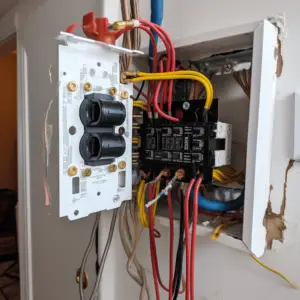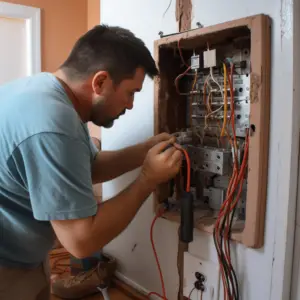Wiring your house can be a real pain. With so many different types of cable, fittings, and tools available to the modern-day homeowner, it can be hard to know where to begin!
If you have older knob and tube wiring in your home and are looking to replace it with something modern, safe, and dependable, romex is definitely the way to go. This guide will show how to replace knob and tube wiring with romex.
Table of Contents
What is Knob-and-Tube Wiring?

Knob and tube wiring was installed in many homes before the 1950s. This type of electrical system consists of a copper wire wrapped around a porcelain or ceramic tube. The wires are then covered with fabric insulation that’s held in place with metal clamps.
Why Should You Replace Your Knob and Tube Wiring?
Knob and tube wiring was used in homes built before 1950, but it hasn’t been installed since 1968. It’s estimated that there are still about 20 million homes with this type of electrical system still in use today.
While this type of wiring isn’t unsafe, it can be very dangerous if it isn’t properly maintained or repaired by an electrician. The problem with knob and tube wiring is that it doesn’t have a ground wire running through it like modern romex does.
If a fire breaks out in your home and there is no ground wire attached to the wall outlet, all the current will go through the wires inside the walls instead of grounding out somewhere else on your property like it would with a modern Romex cable. When this happens, it could cause serious damage to your electrical system as well as burn down your entire house.
How do You Know if You Have Knob-and-Tube wiring?
If you’re unsure whether your home has knob and tube wiring or not, look for the following clues:
- Is your home more than 50 years old?
- Do you have an old fuse box?
- Are there electrical wires under your floors or on the inside of the walls?
- Does your home have a two-wire electrical system instead of a three-wire system?
- Do you see ceramic knobs on wooden joists in your attic or basement?
- Do you see porcelain tubes running through holes drilled through wooden beams and studs in your attic or basement?
- Does your house have single light switches that control one light fixture rather than two switches that control two separate fixtures?
- Is the electrical panel box labeled “Federal Pacific Electric”, “FPE Stab-Lok”, “Zinsco”, “Zinsco/Sylvania”, or “Pushmatic Bulldog”?
If you answered yes to any of these questions, then it is likely that your home has a knob-and-tube wiring system, and you may need to replace it with romex.
What is Romex?
Romex is a brand name for NM-B, which stands for Non-Metallic sheathed cable. This type of cable was developed by the National Electrical Manufacturers Association and represents a standard for non-metallic cable that has been widely adopted throughout North America. It’s used in residential, commercial, and industrial settings as well as power distribution applications.
Romex is typically available in white or gray colors but can also be found in black if you’re looking for something that matches your existing wall coverings. It comes in several sizes, so make sure you buy the right one based on the wire gauge of your existing knob-and-tube wiring (typically 12/2 or 14/2).
Why Should You Use Romex? What Makes it Better?
As mentioned above, knob and tube wiring’s is not a bad way to wire your home. It’s just not the best way, and if you want to upgrade your home from knob and tube wiring, romex is the way to go.
There are several reasons you should use romex. First of all, it’s safe and easy to work with. It can be run through just about any space without the risk of burning. This is especially important when running romex through a hot attic or crawlspace. It’s also easier to work with because it doesn’t require the use of as many tools as knob and tube does. Romex can carry more amps than knob and tube, and it comes in different sizes to accommodate more or less current as needed.
On top of that, romex is easier to install and maintain—you can run romex through holes without having to wrap it in tape like you would with knob and tube wiring. It’s also more affordable than knob and tube wiring. This means you can do more with your money when hiring an electrician or choosing materials. Most importantly, however, romex is much safer than knob and tube wiring.
How to Replace Knob and Tube Wiring’s with Romex

Knob and tube wiring can be really dangerous. The wire insulation is made of rubber, and if it cracks or breaks, you could lose some of the insulation that’s meant to keep you safe from electrocution. That’s why it’s a good idea to replace old knob and tube wiring with new Romex wiring. Here are the steps you need to take.
- First, you need to make sure the power to your house is shut off. You can shut off power at your main breaker or at your fuse box.
- Remove the wire connections where they connect to the terminals of your outlets, switches, and electrical devices like fans and lights. Some of these wires will be connected using screws, so remove those first before unscrewing wire nuts from around the wires themselves.
- Now it’s time to remove the knob and tube wires from their fasteners along joists and studs (this should be a relatively easy task).
- Next up is replacing any old outlets with new ones that have copper connections instead of aluminum ones—older outlets tend to have aluminum connections, which can corrode over time and cause problems like sparking and even fires as a result.
- Run new romex between the wall plate and each outlet from the breaker box. Make sure there are no screws or plugs sticking out of either end of your Romex wire; if there are, cover them with black plastic tape.
- That’s all there is to it!
Can You Replace Knob and Tube Wiring Yourself?
Yes, with some patience, knowledge, and experience or by hiring a licensed electrician to do it for you. In most cases, it’s cheaper to hire an electrician than buy all of the materials yourself.


